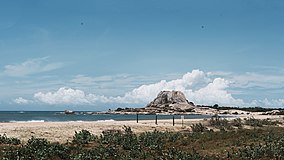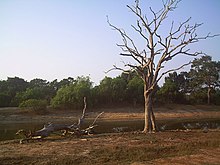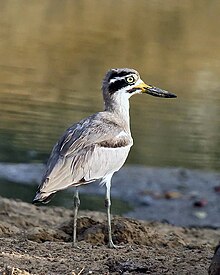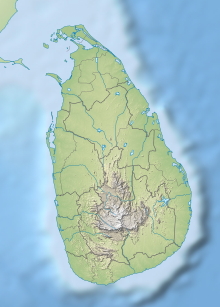Yala National Park
| Yala National Park | |
|---|---|
| යාල ජාතික වනෝද්යානය யால தேசிய வனம் | |
 Patanangala, a rock outcrop in the Yala beach | |
| Location | SouthernandUvaProvinces,Sri Lanka |
| Nearest city | Hambantota |
| Coordinates | 6°22′22″N81°31′01″E/ 6.37278°N 81.51694°E |
| Area | 978.807 km2(377.919 sq mi) |
| Established | 1900 (Wildlife sanctuary) 1938 (National park) |
| Governing body | Department of Wildlife Conservation |
| Website | www |
Yala (යාල) National Parkis the most visited and second largestnational parkinSri Lanka,bordering theIndian Ocean.The park consists of five blocks, three of which are now open to the public. There are also two adjoining parks,Kumana National Parkor 'Yala East' andLunugamvehera National Park.The blocks have individual names, such as Palatupana (Block 1). It is situated in the southeastern region of the country, in theSouthern ProvinceandUva Province.The park covers 979 square kilometres (378 sq mi) and is located about 300 kilometres (190 mi) fromColombo.Yala was designated as awildlife sanctuaryin 1900, along withWilpattu,designated in 1938, as the first two designated national parks in Sri Lanka. The park is best known for its variety of wildlife and is important conservation ofSri Lankan elephants,Sri Lankan leopardsand aquatic birds.
There are six national parks and three wildlife sanctuaries in the vicinity of Yala. Among the largest isLunugamvehera National Park.The park is situated in thedry semi-arid climatic regionand rain is received mainly during thenortheast monsoon.Yala hosts a variety ofecosystemsranging from moist monsoon forests to freshwater and marinewetlands.It is one of the 70Important Bird Areas(IBAs) in Sri Lanka. Yala harbors 215 bird species including six endemic species of Sri Lanka. The number ofmammalsthat has been recorded from the park is 44, and it has one of the highestleoparddensities in the world.
The area around Yala has hosted several ancient civilizations. Two important Buddhist pilgrim sites,SithulpahuwaandMagul Vihara,are situated within the park. The2004 Indian Ocean tsunamicaused severe damage on the Yala National Park and 250 people died in its vicinity. The number of visitors has been on the rise since 2009, after the security situation in the park improved.
History[edit]
In 1560 Spanish cartographer Cipriano Sanchez noted Yala in his map "is abandoned for 300 years due to insalubrious conditions."[1]Chief Justice SirAlexander Johnstonwrote a detailed account on Yala in 1806 after travelling fromTrincomaleetoHambantota.On March 23, 1900, the government proclaimed Yala andWilpattureserves under the Forest Ordinance.[2]Initially the extent of the reserve was 389 square kilometres (150 sq mi) between the Menik and Kumbukkan Rivers. At that time the reserve did not bear the name Yala. The Game Protection Society (now the Wildlife and Nature Protection Society) was instrumental in establishing the reserve. The forest area between Palatupana and Yala was declared a hunting site reserved only for the resident sportsmen.[2]Henry Engelbrechtwas appointed as the first park warden.

On 1 March 1938, Yala became a national park when the Flora and Fauna Protection Ordinance was passed into law byD. S. Senanayake,the minister of agriculture. The park consists of five blocks.[3]Subsequently, four other blocks were incorporated to the park. There are six national parks and three wildlife sanctuaries in the vicinity of Yala.Kumana National Park,Yala Strict Nature Reserve and Kataragama, Katagamuwa, and Nimalawa sanctuaries are continuous with the park.[2]
| Block | Extent | Date added to the park |
|---|---|---|
| Block I | 14,101 hectares (54.44 sq mi) | 1938 |
| Block II | 9,931 hectares (38.34 sq mi) | 1954 |
| Block III | 40,775 hectares (157.43 sq mi) | 1967 |
| Block IV | 26,418 hectares (102.00 sq mi) | 1969 |
| Block V | 6,656 hectares (25.70 sq mi) | 1973 |
| Source:Sri Lanka Wetlands Information and Database[3] | ||
Physical features[edit]

The Yala area is mostly composed ofmetamorphic rockbelonging to thePrecambrianera and classified into two series, Vijayan series and Highland series. Reddish brown soil and lowhumicgrey soil are prominent among sixsoil types.Yala is situated in the lowestpeneplainof Sri Lanka, which extends from Trincomalee to Hambantota. Topographically the area is a flat and mildly undulating plain that runs to the coast with elevation is 30 metres (98 ft) close to the coast while rising in the interior to 100–125 metres (328–410 ft). The national park is situated in thedry semi-arid climatic regionand rain is received mainly during thenortheast monsoon.The mean annual rainfall ranges between 500–775 millimetres (19.7–30.5 in) while the mean temperature ranges between 26.4 °C (79.5 °F) in January to 30 °C (86 °F) in April. It is windier in Yala, during the southwest monsoon compared to the wind during the northeast monsoon with wind speeds from 23 kilometres per hour (14 mph) to 15 kilometres per hour (9.3 mph).[3]
Water is abundant after the northeast monsoon, but during the dry season surface water becomes an important factor. The bodies of surface water appear in the forms ofstreams,tanks, waterholes, rock pools, andlagoons.Waterholes occur in low lying places while rock pools of varying size are capable of containing water year-round, and are hence an important source of water for elephants. For many water birds andwater buffaloesnatural waterholes are ideal habitats. Such reservoirs are largely concentrated to the Block I followed by Block II. Several tanks are there including, Maha Seelawa, Buthawa, Uraniya, and Pilinnawa tanks.[2]Many rivers and streams flow in a southeasterly direction, originating in the highlands of adjacent Uva and central hills. Kumbukkan Oya in the east and Menik River and its tributaries in the west flow across the park, and provide an important water source in the dry season to wild animals of the park. Normally the streams of the park are dry during thedroughtseason. These rivers and streams exhibit a degree ofrunofffluctuations between wet and dry seasons. Kumbukkan Oyadischargesseven times as much water in the rainy season than in the dry season. A number of lagoons are situated along the coast line of the park.[3]There are several routes to get to Yala fromColombo,while the route viaRatnapuraandTissamaharamais the shortest with 270 kilometres (170 mi).[2]
Impact of the 2004 tsunami[edit]
Yala lay in the direct path of the2004 Indian Ocean tsunami,which impacted Sri Lanka 90 minutes after its generation.[4]The tsunami caused severe but localized damage on the park,[5]with around 250 people being killed.[6]The tsunami wave was reported to be 20 feet (6.1 m) high. The tsunami waves reached inland only through the river-mouth gaps in thecoastal dunes.[7]Inundation distances from ranged up to 392 to 1,490 metres (429 to 1,629 yd). The main habitats affected are scrub forest and grasslands. About 5,000 hectares (19 sq mi) of grassland, forest, and wetland were directly affected by the tsunami. Thesatellite imagesrevealed that meannormalized difference vegetation index(NDVI) range from 0.245 to 0.772 in the Block I and II. After the disaster the NDVI value fell dramatically to 0.2111. Around 60% of the area along the coastline has changed. The damage was worse closer to the sea.[5]The movement patterns of tworadio collaredelephants were analyzed. The study found out that their movements were consistent with behaviour prompted by immediate cues generated by the tsunami waves rather than a response to a "sixth sense".[8]
Flora[edit]

Yala National Park has a variety ofecosystemsincludingmoist monsoon forests,dry monsoon forests,semi deciduous forests, thorn forests,grasslands,marshes, marinewetlands,and sandy beaches.[3]The area under forest cover mainly consists of Block I andrangelandsof open parkland (pelessagrasslands) including some extensive grasslands. The forest area is restricted to around the Menik River while rangelands are found towards the sea side. Other habitat types of the Block I are tanks and water holes, lagoons andmangrovesandchena lands.The mangrove vegetation in the Buthuwa lagoon is largelyRhizophora mucronatawhileAvicenniaspp. andAegicerasspp. are less abundant. The vegetation of Block II is similar to those of Block I, and Yalawela, once a fertilepaddy field,representspitiyagrasslands. The mangroves of Block II occur around the estuary of Menik River, which extend to 100 hectares (0.39 sq mi). The common mangrove plants areRhizophora mucronata,Sonneratia caseolaris,Avicenniaspp., andAegiceras corniculatum.The lagoons of Pilinnawa, Mahapothana, and Pahalapothana are also located in this block.[3]The other common mangrove species areAcanthus ilicifolius,Excoecaria agallocha,andLumnitzera racemosa.In the bare sandCrinum zeylanicumis found.[9]
In the Blocks III, IV, and V, forests are more widespread. Thecanopyof the forest mainly containsDrypetes sepiariaandManilkara hexandraplant species. ThePitiyagrasslands are important forgrazinganimals.Cynodon barberiis the common grass inpitiyagrasslands whileZoysia matrellabecomes dominant near the beach. Among 300 odd floral species areManilkara hexandra,Drypetes sepiaria,Ceylon satinwood,Terminalia arjuna,limonia,Berrya cordifolia,Randia dumetorum,Pleurostylia opposita,Gymnema sylvestre,bell mimosa,neem,banyan,toothbrush tree,Schleichera oleosa,Vitex pinnata,Indian blackberry,Gmelina asiatica,Carissa spinarum,Euphorbia antiquorum,andAcacia eburnea.[2]In the seasonally flooded areas of Block II, a wild species ofriceis found.Glenniea unijugais an endemic plant species found around the wetlands of the park.Munronia pumila,Salacia reticulata,andAsparagus racemosusare somemedicinal plants.[3]
Fauna[edit]
Birds[edit]

Yala is one of the 70Important Bird Areas(IBAs) in Sri Lanka.[10]Of 215 bird species of the park, seven are endemic to Sri Lanka.[2]They areSri Lanka grey hornbill,Sri Lanka junglefowl,Sri Lanka wood pigeon,crimson-fronted barbet,black-capped bulbul,blue-tailed bee-eaterandbrown-capped babbler.The number of waterbirds inhabiting wetlands of Yala is 90 and half of them aremigrants.[3]Waterfowl(lesser whistling duck,garganey), cormorants (little cormorant,Indian cormorant), large waterbirds (grey heron,black-headed ibis,Eurasian spoonbill,Asian openbill,painted stork), medium-sized wadersTringaspp., and small wadersCharadriusspp. are among the most common waterbirds.Black-necked storkandlesser adjutantare many of the rare birds that can be seen in the park. The migrantgreat white pelicanand residentspot-billed pelicanare also have been recorded. Other waterbirds attracted to the Yala lagoons includelesser flamingo,pelicans,and rare species such aspurple heron,night herons,egrets,purple swamphen,andOriental darter.Thousands of waterfowls migrate to the lagoons of Yala during the northeast monsoon. They arenorthern pintail,white-winged tern,Eurasian curlew,Eurasian whimbrel,godwits,andruddy turnstone.The visiting species mingled with residinglesser whistling duck,yellow-wattled lapwing,red-wattled lapwing,andgreat stone-curlew.Rock pigeon,barred buttonquail,Indian peafowl,black stork,black-winged stilt,andgreater flamingoare among the other bird species.Crested serpent eagleandwhite-bellied sea eagleare theraptorsof the park. The forest birds areorange-breasted green pigeon,hornbills,Old World flycatchers,Indian paradise flycatcher,Asian barbets,andorioles.[9]
Mammals[edit]



IncludingSri Lankan elephant,44 species of mammals are resident in Yala National Park,[2]and it has one of the highestleoparddensities in the world.[11]25 individualleopardsare estimated to roam in Block I.[12]The elephant herd of Yala contains 300–350 individuals.[13]TheSri Lankan sloth bear,leopard, elephant, andwild water buffaloare all threatened mammals that Yala harbours. Although water buffaloes are indigenous to Sri Lanka, most populations contain genes of thedomestic stockor have descended fromferalpopulations.Toque macaque,golden palm civet,red slender loris,andfishing catare among the other mammals that can be seen in Yala. The elephant population of the park varies seasonally.[9]
Reptiles[edit]

The reptile fauna recorded from the park is 47 and six of them are endemic.Sri Lankan krait,Boulenger's keelback,Sri Lankan flying snake,painted-lip lizard,Wiegmann's agama,andBahir's fan-throated lizardare the endemic species.[2][14]The coastal line of the park is visited by the all five globallyendangered sea turtles(leatherback turtle,olive ridley,loggerhead sea turtle,hawksbill turtle,andgreen turtle) that visit Sri Lanka.[2][3]The two breeding crocodile species of Sri Lanka,mugger crocodileandsaltwater crocodile,inhabit the park. TheIndian cobraandRussell's viperare among the other reptiles.[9]
Amphibians[edit]
There are 18amphibianspecies that have been recorded from Yala, whileBufo atukoraleiandAdenomus kelaartiiare endemic to Sri Lanka.[citation needed]
Fish[edit]
In the water courses of Yala, 21freshwater fishare found.[2]The fish population in the perennial reservoirs contain mostlyexoticfood fishMozambique tilapia.[3]Thestone suckerandEsomus thermoicosare endemic among other species. Theblackspot barb,olive barb,orange chromideandcommon spiny loachare the common fish species.
Invertebrates[edit]
Crabsandprawnsinclude the fauna in the lagoons of the park.[9]
A variety of butterfly species is found here. Thecommon bluebottle,common lime butterfly,crimson rose,common Jezebel,andcommon Mormonare the common species.[2]
Cultural importance[edit]

Yala had been a center of past civilisations.[9]KingRavana,the mythical Hindu anti-hero is believed to have establishedhis kingdomhere withRavana Kotte,now submerged in the sea, as its boundary.[citation needed]Seafaring traders brought Indo-Aryan civilisation with them, as Yala is situated in their trading route. A large number of ancient although disrepairedtanksare the evidence of a rich hydraulic and agricultural civilisation dating back to 5th century BC.[3]Situlpahuwa, which was the home for 12,000arahants,is situated within the park area along with Magul Vihara, which built in 87 BC and Akasa Chaitiya, which constructed in 2nd century BC. Agriculture flourished in area during the period ofRuhuna Kingdom.According toMahavamsa,the Kingdom of Ruhuna began to decline by the end of the 13th century AD. During the colonial period Yala became a popular hunting ground. Yala is annually visited by 400,000 pilgrims.[15]
Threats and conservation[edit]
Poaching,gem-mining,logging,encroachment by agriculture, and free-roaming domesticlivestockare the main threats to the park.[9]Three wardens have been killed in clashes with poachers. Gems are mined along the Menik River and holes created by gem mining, which extend up to 30 metres (98 ft), can be seen along the Kumbukkan Oya. In Blocks III and IV, the encroachment is severe aschena cultivationand burning, to providegrazingin the dry season, collides with the boundary. A large grove ofSonneratia caseolarisis faced withforest diebackin the Menik River's estuary. Cultivation of tobacco,noiseandairpollutions caused by uncontrolled tourism are the otherconservation issues.The growth ofinvasivealienspecies such asLantana camara,Opuntia dillenii,Chromolaena odoratais threatening the native plants.[3]
Deep within the forest,Ganjais cultivated in cleared areas.[9]The wildlife is poached and disturbed by the fishermen at Patanangala. The turtles are caught in fishing nets and the fishermen also litter the beach with debris. They have also set traps inland and dig up turtle nests. In the absence of hand-weeding, which was practiced until the 1950s, the transformation of interior grasslands toscrub jungleis unavoidable. The tourism has created problems in the past, such as vehicles harassing wild animals. The issue is most severe in Sithulpahuwa where thousands of pilgrims visit, leading to a great degree of commercialisation.Department of Wildlife Conservationhas taken some conservation measures such as management of grazing lands, conservation of small water ponds, and eradication of invasive alien species. A 40 kilometres (25 mi) longelectric fencewas erected to prevent elephants from moving into nearby villages.[3]
Tourism[edit]

The Yala National Park is the most visited park in Sri Lanka.[3]In 2002 around 156,867 tourists visited the park. Foreigners, especially Europeans, account for 30% of total visitors.[16]Block I is the main area for visits. Block III (main gate in Galge area, on Buttala-Kataragama Road) and the adjoiningKumana Parkor 'Yala East' (main gate at Okanda, on the east coast not far from Pottuvil) however are becoming popular in their own right too.
Note that the Situlpahuwa pilgrimage site, geographically in Block III, has kind of an 'enclave' status and is accessible FOC through separate roads from Tissa and Kataragama. Most of the visitors stated that reasons for their visit is to see wild animals, and elephant is the most preferred animal. The visitors like to see bears, leopards, birds as well. In 2000 the income from visitors including lodge fees was approximatelyUS$468,629.[15]Due to security conditions revenue was lost.[17]The Yala National Park has been susceptible to terrorist attacks. On 17 October 2007 a group ofLTTEcadres attacked an army detachment in Thalgasmankada in the park.[18]The attack killed sixarmy soldiersand another was caught up in a landmine explosion. On 11 July 2008 four people died in an attack launched by the LTTE.[19]The cadres opened fire at a bus carrying pilgrims toKataragama.Since the end of thecivil war,May 2009, no violence has occurred in Yala area also and it is fully safe for visitors; this was also the main factor in opening blocks III and V for tourists.
From January to June in 2008, 9,078 local tourists and 7,532 foreigners have visited Yala. For the same period of time in 2009 the arrivals have risen to 18,031 locals and foreigners to 10,439. Accordingly, the revenue increased to Rs. 27 million (US$235,000) in 2009 from Rs. 16.6 million (US$154,000) in 2008. The visitors are allowed to see the wild animals from 5.30 am to 6.30 pm.[2]Due todroughtsthe park used to be closed to tourists from 1 September, to 15 October annually; however in 2009 and 2010 the closure was skipped and lakes filled with water bowsers for drinking water for the animals, a future strategy on drought handling is not yet clear.
See also[edit]
References[edit]
- ^Brohier, R. L. (2001). Hewawasam, Abhaya (ed.).Brohier dutu Lankawa[The Ceylon that Brohier seen] (in Sinhala) (2nd ed.). Sooriya Publishers. pp. 312–320.ISBN978-955-9348-63-4.
- ^abcdefghijklmSenaratna, P.M. (2009). "Yala".Sri Lankawe Jathika Vanodhyana(in Sinhala) (2nd ed.). Sarasavi Publishers. pp. 22–69.ISBN978-955-573-346-5.
- ^abcdefghijklmn"Ruhuna National Park".Sri Lanka Wetlands Information and Database.International Water Management Institute.Archived fromthe originalon 26 July 2011.Retrieved15 March2010.
- ^Fernando, Prithiviraj; Wikramanayake, Eric D.; Pastorini, Jennifer (10 June 2006)."Impact of tsunami on terrestrial ecosystems of Yala National Park, Sri Lanka"(PDF).Current Science.90(11): 1531–1534.
- ^abL. Ratnayake, Ranitha."Impact of tsunami disaster on the integral Yala National Park (Sri Lanka) vegetation cover using remote sensing"(PDF).Sri Lanka.
{{cite journal}}:Cite journal requires|journal=(help)[permanent dead link] - ^"Earthquake: Tsunami closes Yala Park".noticias.info.28 December 2004. Archived fromthe originalon 20 February 2009.Retrieved18 March2010.
- ^Moore, A. L.; McAdoo, B. G.; Ranasinghe, N. (December 2007). "2004 South Asia tsunami left little record of its trace near Yala, southeastern Sri Lanka".American Geophysical Union, Fall Meeting.31:OS31A–0168.Bibcode:2007AGUFMOS31A0168M.
- ^Wikramanayake, Eric; Fernando, Prithiviraj; Leimgruber, Peter (2006)."Behavioral Response of Satellite-collared Elephants to the Tsunami in Southern Sri Lanka"(PDF).Biotropica.38(6): 775–777.doi:10.1111/j.1744-7429.2006.00199.x.S2CID85358582.
- ^abcdefghGreen, Micahael J. B. (1990).IUCN directory of South Asian protected areas.IUCN.pp.242–246.ISBN978-2-8317-0030-4.
- ^"Important Bird Area factsheet: Yala, Sri Lanka".birdlife.org.BirdLife International.2009.Retrieved18 March2010.
- ^Kittle, Andrew (May 10, 2009)."Tracking the Lankan Leopard".The Sunday Times.Retrieved27 February2010.
- ^Santiapillai, Charles; Chambers, M.R.; Ishwaran, N. (May 1982). "The leopard Panthera pardus fusca (meyer 1794) in the ruhuna national park, Sri Lanka, conservation".Biological Conservation.23(1): 5–14.doi:10.1016/0006-3207(82)90050-7.
- ^Perera, B. M. A. Oswin (2007)."Status of Elephants in Sri Lanka and the Human-Elephant Conflict"(PDF).
{{cite journal}}:Cite journal requires|journal=(help)[permanent dead link] - ^"Species | the Reptile Database".
- ^abBuultjens, J.; Ratnayake, I.; Gnanapala, A.; Aslam, M (2005)."Tourism and its implications for management in Ruhuna National Park (Yala), Sri Lanka"(PDF).Tourism Management.26(5): 733–742.doi:10.1016/j.tourman.2004.03.014.Archived fromthe original(PDF)on 2006-11-02.
- ^Weerasinghe, U. M. I. R. K.; Kariyawasm, Dayananda; De Zoysa, Mangala."Ruhuna (Yala) National Park in Sri Lanka: visitors, visitation and Eco-tourism".fao.org.Food and Agriculture Organization.Retrieved17 March2010.
- ^Prematunge, Sajitha (26 July 2009)."Revamping national parks in a post-war setting".Sunday Observer.Archivedfrom the original on 5 June 2011.Retrieved17 March2010.
- ^"Not a feather in Tiger cap".Sunday Observer.21 October 2007.Archivedfrom the original on 23 January 2008.Retrieved18 March2010.
- ^Wijayapala, Ranil; Yatawara, Daneshi (12 July 2008)."Tigers fire at bus killing four".Daily News.Archived fromthe originalon 4 June 2011.Retrieved18 March2010.
External links[edit]
![]() Media related toYala National Parkat Wikimedia Commons
Media related toYala National Parkat Wikimedia Commons

